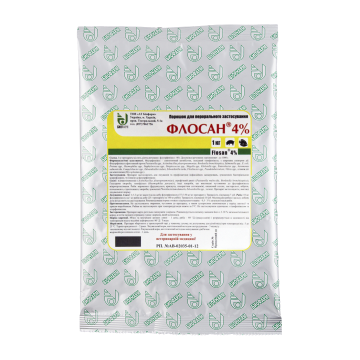FLOSAN® powder
powder for oral administration
Description
White water-insoluble powder.
Composition
1kg of the drug contains:
active ingredient: florfenicol – 40 g;
Excipient: semolina.
powder for oral administration
Description
White water-insoluble powder.
Composition
1kg of the drug contains:
active ingredient: florfenicol – 40 g;
Excipient: semolina.
Pharmacological properties
ATCvet: QJ01– antibacterials for systemic use. QJ01BA90 - Florfenicol.
Florfenicol is a synthetic broad-spectrum antibiotic, a derivative of thiamfenicol. The mechanism of action consists in inhibition of microbial cell peptidyl transferase enzyme activity, particularly in the area of 70S ribosomes. Florfenicol is effective against gram-positive (Staphylococcus spp., Streptococcus spp.) and gram-negative (Pasteurella spp., Actinobacillus pleuropneumoniae, Bordetella bronchiseptica, Salmonella spp., Escherichia coli, Proteus spp., Haemophilus spp., Shigella spp., Klebsiella spp., Enterobacter spp., Aeromonas salmonicida, Campylobacter spp., Edwardsiella ictaluri, Edwardsiella tarda, Flexibacter spp., Pseudotuberculosis, Vibrio spp.) microorganisms, as well as mycoplasmas (Mycoplasma spp.).
After oral administration, florfenicol is well absorbed (up to 90%) from digestive tract and distributed in organs and tissues, reaching concentrations of 4-8 μg/g in lungs, heart, pancreatic gland, skeletal muscles and spleen. Therapeutic concentration is preserved for 21-23 hours. Relatively high concentrations are present in bile, kidneys, small intestine and urine. Urinary metabolites are composed of florfenicolamine, florfenicol oxamic acid and monochloroflorfenicol. Florphenicolamine is the most long-term metabolite present in liver. About 64% of florfenicol is biotransformed into florfenicol amine. Half-life of florfenicol makes 2.6-3.2 hours on average. Florfenicol is primarily excreted in urine unchanged - up to 50%.
The bioavailability of florfenicol in fish, when administered orally, is about 96.5% (10 mg/kg dose, at water temperature of 10.8 ± 1.5 ˚C). It is well distributed in body organs and tissues, reaching a concentration of 4-10 μg/g in 6 hours. Concentrations in muscles and blood are similar to serum concentrations, while fat and central nervous system (CNS) have lower concentrations (25%). Half-life period makes 9-12 hours.
Administration
Swine: Treatment of animals against pleuropneumonia (Actinobacillus pleuropneumoniae), atrophic rinitis (Pasteurella multocida, Bordetella bronchiseptica), hemophilic polyserositis (Haemophilus parasuis) as well as other diseases of respiratory organs caused by florfenicol-sensitive microorganisms.
Fish (carps, salmons): treatment of fish against red spot disease (bacterial hemorrhagic septicemia), furunculosis (salmon bacterial hemorrhagic septicemia), salmon Glasser's disease, pasteurellosis, secondary bacterial infections after stress caused by florfenicol-sensitive microorganisms (Photobacterium damsela, Edwardsiella spp., etc.).
Dosage
Orally with feed in the following doses:
swine - 1.25 g of the drug per 10 kg body weight (5 mg of florfenicol per 1 kg body weight daily). Duration of treatment- 7 days;
fish (carps, salmons): 10 mg of florfenicol per 1 kg of fish daily (25 g of the drug per 100 kg of fish). Duration of treatment- 10 days. Divide daily dose in two feedings for small-size and juvenile fish. Recommended dose of ready-made medicated feed – 0.5-3% of total fish weight.
For treatment of swine against Glasser's disease, administer the drug individually to every animal.
When preparing medicated feed for fish, apply the drug on the surface or add it inside the feed before extrusion. In case of individual preparation of medicated feed prepare the mixture immediately before administration. For this, use the required amount of feed and drug and mix them thoroughly. Use fish oil or vegetable oil in amount of 2% of ready feed weight (2 l per 100 kg of the feed) as a binding component. For better mixing, mix the drug with a small amount of feed first and then - with the rest of the feed. The feed is thoroughly to obtain homogeneous mass. A mechanical stirrer may be used for preparation.
Contraindications
Do not administer to animals with hypersensitivity to florfenicol.
Do not administer in pregnant and lactating animals and breeding boars.
Do not feed the drug to fish if water temperature is below 5 °C.
Do not use in combination with antibiotics of the penicillin group, cephalosporins and fluoroquinolones as well as thiamfenicol and chloramfenicol.
Do not use in combination with preparations containing cations Mg2 +, Al3 +, Ca2 +, as the latter may bind to florfenicol and impair its absorption.
Precautions
Side effect
If the drug is administered in recommended doses, side effects do not appear.
Possible allergic reactions. In case of allergic reactions, the drug is discontinued and antihistamines are prescribed to the animal; if necessary, administer symptomatic treatment.
Sometimes treatment with the drug in swine can cause redness in the perineum and diarrhea. These changes are reversible and short-term, they have no effect on the general condition of the animals.
When the drug is administered in fish in the recommended doses, side effects do not appear.
Special precautions for administration
The drug shall be thoroughly mixed with the feed. It is recommended to mix it with 3-10% of the total feed first, then mix the resulting mixture with the remaining feed.
Excretion (withdrawal) period
Animal slaughter for meat is possible in 2 days, fish may be consumed in 16 days (fish - if water temperature is 5-10 °C) and 8 days (fish if water temperature is above 10 °C) following the last drug administration. Meat, obtained before the mentioned term, shall be utilized or fed to non-productive animals depending on the statement of a veterinary physician.
Packaging
Packages made of film or foil materials of 100 g, 500 g and 1 kg.
Storage
Store in a dry dark place out of the reach of children at 5-25 °С.
Shelf life - 2 years.
Medicated extruded - 3 months if stored in a dry dark place at 25 °C max. Medicinal feed, mixed with fish oil or vegetable oil - 1 day.
For use in veterinary medicine!
